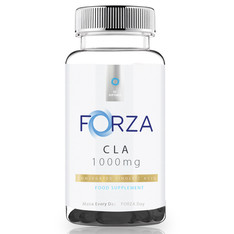
Widespread interest in the potential health benefits of conjugated linoleic acid (CLA) especially in conjunction with polyunsaturated fatty acids (n-3 LC-PUFAs) abounds.
Animal studies have largely shown that CLAs in particular can reduce, almost inhibit certain types of cancer and influence weight reduction, general energy metabolism and even diabetes. There is some controversy over its use for weight management.
Conjugated linoleic acid is a mixture of both geometric and positional isomers of linoleic acid where the double bonds are conjugated. The natural source for these omega-6 fatty acids is through microbial isomerization of dietary linoleic acid (Chin et al., 1994).
There are some excellent reviews on the health benefits of CLA (Belury, 2002; Wahle et al., 2004; Bhatacharya et al., 2006; Dilzer and Park, 2012; Hennessy et al., 2016).
The supplement is generally used by sports people especially body builders and athletes.
Products Containing Conjugated Linoleic Acids
 There are a number of supplements available and please note this article contains links to our affiliate marketing partners. Please read our affiliate disclosure.
There are a number of supplements available and please note this article contains links to our affiliate marketing partners. Please read our affiliate disclosure.
Forza supply the conjugated linoleic acid (CLA) as 1g amounts in 90g capsules.
Our Amazon affiliate offers the following varieties of CLA from the following suppliers:- Iron Ore Health, eBody Ltd., Elite Health, Zestlife and Iron Labs Nutrition. All of these are in capsule form.
Please also look out for brands that offer CLA along with other weight management ingredients for example such as Garcinia camboga and Green Tea leaf extract. See Evlution Nutrition for inclusion of these ingredients.
References
Belury, M. A. (2002). Dietary conjugated linoleic acid in health: physiological effects and mechanisms of action 1. Ann. Rev. Nutrition, 22(1), pp. 505-531
Bhattacharya, A., Banu, J., Rahman, M., Causey, J., & Fernandes, G. (2006). Biological effects of conjugated linoleic acids in health and disease. J. Nutritional Biochemistry, 17(12), pp. 789-810.
Chin, S. F., Storkson, J. M., Albright, K. J., Cook, M. E., & Pariza, M. W. (1994). Conjugated linoleic acid is a growth factor for rats as shown by enhanced weight gain and improved feed efficiency. J. Nutrition, 124(12), pp. 2344-2349
Dilzer, A., & Park, Y. (2012). Implication of conjugated linoleic acid (CLA) in human health. Critical Reviews in Food Science and Nutrition, 52(6), pp. 488-513
Hennessy, A. A., Ross, P. R., Fitzgerald, G. F., & Stanton, C. (2016). Sources and bioactive properties of conjugated dietary fatty acids. Lipids, 51(4), pp. 377-397
Wahle, K. W., Heys, S. D., & Rotondo, D. (2004). Conjugated linoleic acids: are they beneficial or detrimental to health? Progress in Lipid Research, 43(6), pp. 553-587

Leave a Reply